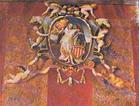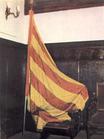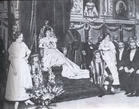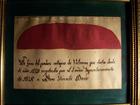<< | Índex | >>
The Flag

Guardian angel of the Kingdom of València. Palace of the Generalitat.
The heraldry of the Reial Senyera or Bandera Reial [royal flag] - the traditional four bars of Aragon over a yellow field - was strong until 1978, when the Blaverists daubed their color everywhere - even on some coats of arms, from that of the Official Chamber of Commerce and Navigation of Valencia to that of the València CF, something heraldically impossible - in an attempt to be opposed to the imminent Valencian democratization and national recovery.
The supposed Senyera de València (flag of the city of València) with the blue color has no written documentation prior to 1876, when the commemorative funeral 600 years after James I's death was held; it was taken to the Cathedral of València. But it is not the same Valencian flag as the one that existed in 1838: the former one was a flag in which it only took two people to hold its points at the fly, whilst the latter one was a tapering pennant, similar to the Pennon of the Conquest. The royal flag of València documented until 1838, a pennant with four carmine bars narrower than the golden field, is not the same as the presumed Senyera documented after 1876 - as the first graphic witnesses of the new flag described - with a peculiar grayish-bluish stripe near the mast, which has a golden decorative border on top, and a red stripe containing a sort of decorative rocks parallel to the other stripe, in addition to the four red bars which now were as wide as what can be described as the stripes of the divided golden field.

"History of En Jaume, the King", written by Gómez de Miedes, year 1584.
However, this does not mean that the presumed new Senyera is from 1876: the fabrics, mat and silver bat that form it are older. But each element dates back to a different time, and together they essentially are a montage from a century and a half ago, at most. The authentic Reial Senyera must have been widely used, especially in the form of a pennon, and, in an incompetent restoration - in which the chronicler Vicent Boix maybe took part -, the entire lower part was removed and its pieces were distributed; one is in the Library of Vilanova i la Geltrú. By analogy with the Royal Flags of the Valencian Courtroom, the four points in which people held the flag became two. The width of the carmine and gold bars was also equalized. But all these changes were not enough. These people, with all their innocence, following a habit of the then-prevailing neo-Gothic, attached the flag to the staff with a piece of light cloth - originally bluish gray, light blue in subsequent paintings and reproductions - and covered the seams with a red stripe containing decorative rocks. They cannot be blamed: for them, the Royal Flag was still golden and red, although and not pennant-shaped: the new addition they assembled was meant to be for the flag of the city of València, not a new part of the original Royal Flag. But the years went by and, for some, the addition would become more important than the main part of the flag.

Flag of Morvedre, currently Sagunt, which has survived to this day.
A few years after this addition, the most respected voices of the Valencian Renaixença (linguistic and national Valencian recovery that took place in the XIXth century) revered the four-striped flag:
-[1877] Vicent Wenceslao Querol, poem Patria, Fides, Amor, included in the Catalan rhymes. Antologia de poetes valencians II: El segle XIX. Edition, selection and study by Eduard J. Verger. València: Alfons el Magnànim Editions (1984).
Mai com avui que Espanya obira envergonyida / trencats corona i ceptre, brut son mantell de fang, / sos fills en lluita infame, i es veu menyspreada i sola, / mai com avui n’és digne qui el gonfanó tremola ab les barres de sang.
Never like today Spain will be so ashamed / broken crown and scepter, mantle dirty of mud, / her children in infamous struggle, and she is despised and alone, / never as today is it worthy of her the one who the standard with the bars of blood trembles.
-[1885] Teodor Llorente, poem A mon llibre, included in the Book of verses. In the following stanza, the author inserts in his book some sentences for the reader. Antologia de poetes valencians II: El segle XIX. Edition, selection and study by Eduard J. Verger. València: Alfons el Magnànim Editions (1984).
Vinc a parlar-te de les teues coses, / i, com pregó ben clar del meu sentit, / porte les quatre barres sanguinoses / i el Rat-Penat al pit.
I come to talk to you about your things, / and, as a clear proclamation of my intentions, / I carry the four bloody bars / and the Bat on the chest.
-[Finals del XIX] Rafael Ferrer i Bigné [València 1836 – 1892. Poet, journalist and founding member of Lo Rat Penat], poem Lo Rat Penat. Antologia de poetes valencians II: El segle XIX. Edition, selection and study by Eduard J. Verger. València: Alfons el Magnànim Editions (1984).
València per a en Jaume! Així ho pregona / la senyera del rei en la ciutat. / Du barres d’Aragó, mes la corona / té dalt un símbol nou: lo Rat Penat.
Valencia for Lord Jaume! So proclaims / the flag of the king in the city. / It has bars from Aragon, plus the crown / and it has a new symbol on it: the Bat.

Floral Games of Lo Rat Penat in 1904
Nevertheless, the Valencianists, never acknowledged the addition. In 1885 Teodor Llorente published his Llibret de versos and in the poem A la Senyera he says drap gloriós d'or y de grana / que corona el Rat penat [glorious cloth of gold and carmine / crowned by the Bat]. For him, the blue color does not exist on the flag. The witnesses can be easily multiplied: Constantí Llombart (los pals... grochs y vermells) [the sticks... yellow and red], Eduard Martínez Ferrando (la magnífica oriflama) [the magnificent oriflamme], Vicent Tomàs i Martí (un llaurador amb la bandera dels quatre pals rojos en camper daurat) [a farmer with the flag of the four red sticks in a golden field], Carles Salvador (penó sang-i-barrat; banderes barrades; una Senyera daurada i vermella; Senyera feta amb roigs i grocs; els roigs i els grocs de senyeres - sang bullent i caliu d'ors -) [blood-barred pennant; Senyera made with red and yellow; the red and yellow color of various Senyeres - boiling blood and warmth of golds -], Miquel Duran i Tortajada (ensenyes... barrades) [ensigns... with bars], and notably Guillem Renat (Josep Giner): ... s'ha conservat el costum vuitcentista d'unir la bandera al pal mitjançant un tros de drap de color, generalment blavós... A València els valencianistes provincians creuen que la llista de color serveix per diferenciar la bandera valenciana de la catalana. Els pobrets no saben ni com era la bandera valenciana medieval! Centenars de vegades està escrit... que la bandera valenciana són quatre pals sobre camp d'or. Per a res s'aludeix a cap color més... Cal usar la bandera valenciana sense dibuixets ni flocs, ni pols, ni cap afegitó més o menys blavós... [... the nineteenth-century usage of attaching the flag to the pole by means of a piece of colored cloth, usually bluish, has been preserved... In València the provincial valencianists believe that the color list serves to differentiate the Valencian flag from the Catalan one. The poor folks don't even know how the medieval Valencian flag was like! It is written hundreds of times... that the Valencian flag consists in four bars on a field of gold. There is no reference to any other color... It is necessary to use the Valencian flag without drawings or flakes, or poles, or any more or less bluish addition...] (1933)

Meeting of el Puig in the thirties, organized by Lo Rat Penat.
In addition, this presumed Senyera with the blue addition has had an unfortunate life. Except for the city of València's own performances, it has often been brought to Madrid without protocol and as a secondary attachment of celebrations not at all appropriate for what the Valencian flag represents:
- in 1881, to a parade to commemorate the second centenary of the death of the Castilian writer Pedro Calderón de la Barca;
- in 1925, to the meeting of town halls convened by the military directorate in support of Primo de Rivera. It should be added that, meanwhile the dictator had enacted laws that prohibited not only the display of flags other than the official, but also the public use of languages -qualified as "dialects" - other than Spanish, in València the Royal Flag was banned together with the traditional hommage to James I and October 9th. Instead, the dictatorship authorities were concerned with officially declaring both the Himne de l'Exposició of Josep Serrano and Maximilià Thous, and the alleged Senyera (in 1928 the marquess of Sotelo ordered a copy of the original deteriorated banner, in which the original bluish gray had already changed to sky blue. Needless to say, both symbols - flag and anthem - were immediately used as a tool to oppose democrats, not only then, but throughout the Republic and the Civil War. And it went on:
- in 1939, to the rostrum of the Francoist Desfile de la Victoria (Victory Parade). The only explanation for this fact is that the flag was there as a winning flag, because the defeated flags - such as the real Royal Flag and the Spanish Republican flag with three colors, the public usage of which was forbidden and would be persecuted, along with the Catalan language, for about forty years - were not allowed.

Metamorphosis of the original flag of València during the 19th century.
We, at last, dispose of an exceptional, almost contemporary, testimony of the facts, that clearly testifies that the blue (or grayish) stripe is an artificial addition of the 19th century. It is a poem by the 19th century Valencian writer Lluís Cebrian (València 1851-1934), that is included in the anthology that was written by one of the fathers of the Valencian Renaixença, and founder of "Lo Rat Penat", Constantí Llombart, Los Fills de la Morta-Viva (València. Imprint of Emili Pasqual, Editor. 1878. Pp. 630-1) [we reproduce both it in its original ortography and in a somewhat literal translation]:
A LA SENYERA DE LA CIUTAT
Hi ha qui diu qu'entusiasme no sent huí
al voret, perque aquella no pots ser:
Perque son tons brodats de un novell fer,
y per qu'es, pera vell, ton domás fi.
Qu'es com dir, que Valencia no está así,
la d'En Jaume, de March y de Ferrer,
perque hermosa y moderna es vá refer
ab empedrats, y fonts, y llums sens fi.
Aixó ho diuen mals fills y mals germans,
que d'amarte, vergonya es fan tan sols
quant d'Espanya se venen braus amans...
Déixals dir; pero fuig d'eixos estols,
que'ls que no saben ser bons valencians,
manco encara sabrán ser espanyols.
TO THE FLAG OF THE CITY
There are some people who say that they don't feel enthusiasm today
when they see you, because that you can't be:
Because your embroideries are of a new making,
and because it is, for the elder, your fine damask.
It is like saying, that València is not present,
the one of Jaume, March and Ferrer,
because beautiful and modern it was remade
with cobblestones, and fountains, and endless lights.
This is what bad sons and bad brothers say,
that they are only ashamed of loving you
when of Spain they say that they are brave lovers...
Let them be, but run away from those who only show their outwards,
because those who do not know how to be good Valencians,
let alone they will know how to be Spaniards.
We notice how here we are told that empedrats, y fonts, y llums sens fi (cobblestones, and fountains, and endless lights) have been added to the original flag. This is the innocent and original intention that the blue or grayish stripe would have. It would be exactly to highlight the most important part, the one that Blaverists later despised: the four bars. Therefore, as some have said, the addition would not imitate any crown, but would rather be an artistic design that would refer to the precious stones that would thus adorn the original four-striped core of the flag. Earlier, Cebrian even clarified it in a much better way, by saying about the flag that son tons brodats de un novell fer (your embroideries are of a new making), and afterwards as well by saying that the original four-striped flag hermosa y moderna es vá refer (beautiful and modern it was remade). We do not have a precise date of when this poem was composed, but if we are guided by the date of publication of Constantí Llombart's anthological work (1878), we can deduce that the blue or grayish addition to the original flag could have been made during that time.

Evidence of the 19th-century modification of the original Valencian senyera.
And we have a much clearer proof of this modification: a piece of the carved flag that was given in 1849 by the Town Hall of València to the historian Vicent Boix, which was personal property of the venerable Valencian Pere Maria Orts i Bosch, who gave it the City Council of València, whose image we attach here. Under the piece of cloth, we can read: Noble girón del pendón antiguo de Valencia que data desde el año 1240 regalado por el Excmo. Ayuntamiento de Valencia de 1849 a D. Vicente Boix (Noble piece of the ancient pennon of València dating from 1240 given by the València City Council of 1849 to Mr. Vicente Boix.) This would, thus, in the absence of other more specific evidence, be the date (or at least a very close date) of the modification of the primitive Senyera of the city of València, made by cutting a piece of the flag and adding the bluish-grayish stripe that imitated precious stones that in any case adorned the main part: the four bars. And this little text would also be a clear proof that such a modification actually took place.
We will finally say that, in any case, this flag we are talking about (the one with blue color) is the flag of the city of València. Obviously, many towns and cities of the Valencian Country have their own flag, and the pretension of the Blaverists to impose the flag of a city to the entire country is therefore unfair. Nonetheless, as we have shown, it turns out that the original flag of the city of València (until the end of the 19th century) was precisely the four-striped flag, which Blaverists hate. But this is not the entire story. According to the Valencian scholar Pere Maria Orts, three flags were kept in the València City Council:

Pennon of the Conquest (València, 1238).
- The Senyera of the city: the four-barred flag that was modified adding blue color in the 19th century.
- The Pennon of the Conquest: also four-barred. Relic of the time of the conquest, which in any case is the oldest Valencian flag of them all. Not only this, but it is the oldest preserved flag of Europe, which all Valencians should be proud of, even those who furiously criticize it.
- The flag of the Kingdom: the four-barred royal standard. It was kept in l'arca de les tres claus (the ark of the three keys) and it was only pulled out of the ark once every hundred years (coinciding with the anniversary of the conquest of València in 1238). This flag is nowadays disappeared. Or maybe someone has hidden it somewhere? Some have leaned towards the last hypothesis, because obviously, if it were ever found, as this was the authentic flag that represented the entire Valencian territory, the arguments in favor of the Blaverist flag would disappear at once.
The Valencian scholar Orts collects the opinion expressed a century before by D.R. Vives Azpiroz in the Folleto escrito para justificar que la Bandera que pusieron los moros, para señal en la torre de Alí Bufat, no es la Real Bandera del Ejército conquistador de Valencia (Brochure written to justify that the Flag that the Moors put, for signal in the tower of Alí Bufat, is not the Real Flag of the conquering Army of València) [València. Imp. of Juan Guix. 1882]. In this pamphlet, as its title indicates, it basically says that the Pennon of the Conquest - the flag that waved in the tower of Alí Bufat as a sign of surrender of the Moors, as it is called - could not be the flag of the conquering army, because the latter one one was of much more quality than the Pennon, woven with coarse fabrics, because according to medieval heraldry, the official flag of an army was woven with quality fabrics. It is also said that the flag of the conquering army could in no way be ceded to the Moors of València, even if it were to be placed as a sign of surrender (which was the basic function of the Pennon of the Conquest), because at any moment they could retain it, and the Christian army would have been left without its most prized symbol.
On pages 17-8 of this booklet, the flags hosted in the City Council of València at the end of the 19th century were described in a summary form. They were:
"A más de otras muchas banderas y Estandartes, tres son las que se guardan en el archivo municipal, y anuestro propósito hacen referencia.
1ª. La bandera llamada de la Conquista.
Esto es, la que como señal tremoló en la torre de Alí-Bufat.
2ª. El antiguo Pendón de la ciudad.
Que ya existía en tiempo de las Germanías.
3ª Y la Real Señera del ejército conquistador de Valencia
Así las distingue a las tres el ilustrado cronista D. Vicente Boix.
La bandera de la Conquista y el antiguo Pendón de la Ciudad se conservan dentro de dos pirámides de cristal, colocadas una enfrente de la otra (Torres).
La Real Señera, dentro de un baúl de baqueta, juntamente con la espada del rey D. Jaime, y las dos llaves doradas, que en señal de pleitesía se le entregaron a Felipe V a su entrada en esta Ciudad (Vives)".
"In addition to many other flags and Banners, there are three that are kept in the municipal archive, and they refer to our purpose.
1st. The flag called the Conquest flag.
That is, the one that trembled at the tower of Alí-Bufat as a signal of surrender.
2nd. The old Pennon of the city.
That already existed in the time of the Germanías.
3rd. And the Royal Senyera of the conquering army of València
This is how the chronicler D. Vicente Boix distinguishes the three.
The flag of the Conquest and the old Pennon of the City are preserved inside two glass pyramids, placed one in front of the other (Towers).
The Royal Senyera, inside a wooden chest, together with the sword of King James I of Aragon, and the two golden keys, which as a sign of homage were given to Felipe V upon his entry into this City (Vives)".
External Links















